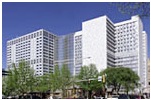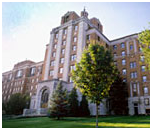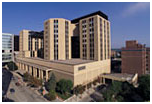From the WONCA President: Team Mayo
First onboard and seated on the aisle, I watched my fellow passengers as they slowly filled the small regional jet. I was struck by how many of them limped, used walking devices, lugged oxygen tanks, or had skin conditions. It took me a moment to comprehend why. Then it came to me – we were headed to Rochester, Minnesota, home of the Mayo Clinic. We were pilgrims making our way to the American equivalent of Lourdes, seeking clarity and cure.

The thought of our collective destination suddenly caused me some anxiety. I was headed to Mayo for a different purpose. I had been invited to speak on global perspectives on primary care reform and innovation. This was a task I had accomplished successfully hundreds of times in dozens of countries. My anxiety arose from uncharacteristic doubts that I may not be up to the assignment. Who was I to offer insights and advice at the medical Mecca to which politicians, royalty, and the wealthy flocked for treatment?
I need not have worried. The evening of my arrival, I shared a delightful dinner with old friends like Rob Nesse and several other Mayo family physicians and residents. Their warm welcome set the tone that was to typify my visit. During my 24 hours in Rochester, I began to understand the reasons for Mayo’s success and mystique. While the Mayo system is very large with lots of intelligent people and considerable resources, I have been to other institutions with similar attributes. What makes Mayo special is that it has nurtured a culture of collaboration that few other multi-specialty polyclinics have achieved. There was an atmosphere of openness, humility, and shared vision that I have observed rarely in other academic health centers. Mayo has created a sense of team centered on the needs and experiences of the patient.
It all started with Dr W W Mayo, who began his practice, in Rochester, in 1863. Two decades later, he was joined by sons William and Charles, with the establishment of the Mayo Clinic, in 1889. Their commitment to innovation and group practice was uncommon for the day. In 1915, Mayo launched the first post-graduate training program in the United States. Over time, the owners of the Mayo practice turned over its assets to what eventually became the Mayo Foundation for Education and Research (“Foundation”), a charitable, not-for-profit organization. Mayo established its own medical school, in 1972. Campuses in Jacksonville, Florida and Scottsdale, Arizona were founded twenty five years ago. The three shield logo reflects Mayo’s values, with patient care at the center, flanked by education and research.
The Mayo Clinic has grown to the largest integrated medical center in the world. In addition to the Rochester, Jacksonville, and Scottsdale campuses, the entire Mayo Clinic Health System now includes more than 70 hospitals and clinics in Iowa, Minnesota, and Wisconsin. In total, Mayo represents more than 3700 physicians and 55,000 additional employees who annually provide care to more than 1 million patients from more than 135 countries. Clinical activities generate about USD8.5 billion in revenues each year.
There are several unique aspects to Mayo. The entire enterprise of clinical services, education, and research is subsumed under the Foundation, which has assets of about USD1.5 billion. Mayo doctors are paid on a salary basis. Any extra income beyond expenses is used for charitable purposes by the Foundation.
The following morning, I had a 6:50am breakfast meeting with Dan Broughton, a Mayo pediatrician, to discuss his work with the International Center for Missing and Exploited Children. At 8am, I attended a care team meeting at the North East Clinic, which houses about two dozen physicians and mid-level practitioners. For thirty minutes, three physicians and 15 nursing staff talked through some of the current issues and problems of patient flow and clinic operations. Following the staff huddle, I had a fascinating discussion with Kristin Somers, a psychiatrist, two mental health nurse specialists, and a social worker. They work exclusively at the North East practice and provide support to the primary care team. Built on the principles of the DIAMOND study (J Gen Intern Med 2011 Sep;26(9):999-1004. Epub 2011 May 20), the mental health professionals have become an integral component of the practice. The primary care doctors still provide most of the behavioral and mental health services, but turn to the mental health specialists when needed. It was one of the better examples I have seen of integrating mental health services with primary care.
St Mary's Hospital
 Rochester Methodist Hospital
Rochester Methodist Hospital
The final two hours of the morning were spent on hospital rounds with the Family Medicine Inpatient Service at Saint Mary’s Hospital. Robert Bonacci, the inpatient attending, led the team through the usual array of problems that cause primary care patients to be hospitalized – heart failure, lung disease, chronic pain, substance abuse, and so on. After my noon presentation, I met with David Katzelnick, a psychiatrist who is doing innovative work around team-based care, especially for those with depression or chronic pain syndromes. I ended my afternoon with Chris Chute, an epidemiologist who is very involved with the ICD (International Classification of Disease) initiative of the World Health Organization.
Weather-related flight delays denied me the chance to see how many of my fellow pilgrims departed Rochester feeling clarified or cured. On the four hour drive home in a rental car, I reflected on my brief, but busy, visit. Mayo’s global reputation was made on its ability to bring experts together over a short period of time to collaborate efficiently and focus intensively on the needs of a single patient. They have done this well, whether for a rare or complex condition or for a wellness examination (the “Executive” physical). It was impressive to see what could be accomplished when skilled professionals joined together in a common purpose aided by excellent support staff and backed by significant resources. Another lesson of Mayo was that leadership matters.
The Mayo culture however, is not for everyone. Non-conformists and egotists will likely be forced to choose between the “Mayo way or the highway.” In an environment where narrow expertise is valued, the comprehensiveness of the family doctor can be seen as implausible. Interestingly, the greatest boon for Family Medicine has proved to be the need of the Mayo system to provide care for its own employees. It seems that Mayo has discovered of late what much of the world has known for some time – better outcomes with higher satisfaction and lower costs result when care is managed by a family doctor.
Professor Richard Roberts
President
World Organization of Family Doctors